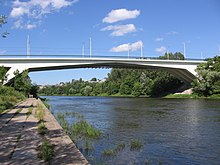Neris
| Neris | |
|---|---|

|
|
| Country | Belarus, Lithuania |
| Basin features | |
| Main source | Belarus |
| River mouth | Neman River |
| Basin size | 25,100 km2 (9,700 sq mi) |
| Physical characteristics | |
| Length | 510 km (320 mi) |
| Discharge |
|
Neris (![]() pronunciation , Belarusian: Ві́лія Viliya, Polish: Wilia) is a river rising in Belarus. It flows through Vilnius (Lithuania) and becomes a tributary of the Neman River (Nemunas) at Kaunas (Lithuania). Its length is 510 km (320 mi).
pronunciation , Belarusian: Ві́лія Viliya, Polish: Wilia) is a river rising in Belarus. It flows through Vilnius (Lithuania) and becomes a tributary of the Neman River (Nemunas) at Kaunas (Lithuania). Its length is 510 km (320 mi).
For 276 km (171 mi) the river runs through Belarus, where it is called Viliya, and 235 km (146 mi) runs through Lithuania, where it is called Neris.
The Neris connects two old Lithuanian capitals – Kernavė and Vilnius. Along its banks are burial places of the pagan Lithuanians. At 25 km (16 mi) from Vilnius are the old burial mounds of Karmazinai, with many mythological stones and a sacred oak.
The reasons for the dual naming of the river as Neris by the Lithuanians and Viliya (formerly Velja, meaning "big, great" in Slavic) by the Slavs are complex. Even in Vilnius, there are toponyms including both names, e. g. Neris remains in the riverside names of Paneriai and Paneriškės while Velja is a part of the name Valakampiai, which means "an angle of Velja" in Lithuanian.
Although it has been suggested that Neris is the primeval name of the river, while name Viliya is of a secondary extraction, the dual naming most probably emerged from the confluence of rivers Neris (now known as Narach River, leaving Lake Narach) and Velja, in the historical Slavic/Baltic borderland, each ethnos choosing their own name for the river starting at the confluence. It is moreover evidenced by the fact that the name Neris was never used to name the river Velja up to this confluence. Therefore, it has been proposed that the Narach River had in fact been considered the upper reaches of Neris by the Balts in ancient times.
...
Wikipedia
